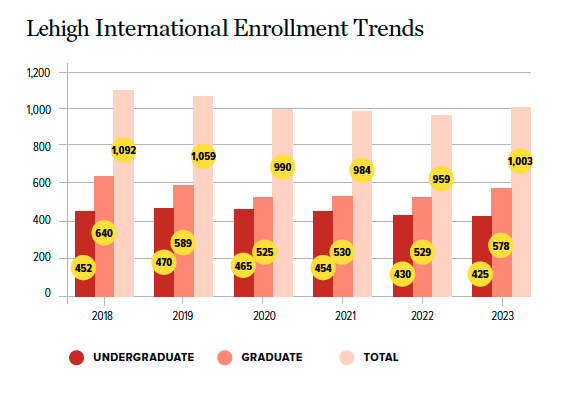
JAKARTA, inca.ac.id – Understanding enrollment trends is essential for universities, policymakers, and students alike. As the landscape of higher education evolves, shifts in demographics, economic factors, and societal expectations significantly influence university populations. This article delves into the current enrollment trends, examining the factors driving these changes and their implications for the future of higher education.
The Current Landscape of Enrollment Trends

Declining Enrollment Numbers
One of the most pressing issues facing higher education today is the decline in enrollment numbers, particularly in traditional undergraduate programs. Many universities have reported significant drops in student populations, raising concerns about their sustainability.
Factors Contributing to Decline
- Demographic Shifts: A notable decrease in the number of high school graduates, especially in certain regions, has led to fewer students entering college. This trend is particularly evident in rural areas where population growth is stagnant or declining.
- Economic Factors: Rising tuition costs and increasing student debt have deterred many potential students from pursuing higher education. The financial burden of attending college is a significant concern for families, leading to a reevaluation of the value of a degree.
- Changing Attitudes: There is a growing perception among young people that a college degree may not be necessary for career success. Many are exploring alternative pathways, such as vocational training or entrepreneurship, which can offer quicker returns on investment.
Increase in Non-Traditional Students
Alongside declining numbers of traditional students, there has been a marked increase in non-traditional students enrolling in higher education. This group includes adult learners, part-time students, and those seeking online education.
Characteristics of Non-Traditional Students
- Age and Background: Non-traditional students are often over the age of 25 and may be balancing education with work and family responsibilities. Many of these individuals are returning to school after years in the workforce, seeking to advance their careers or change fields.
- Flexibility Needs: The demand for online and hybrid learning options has surged as non-traditional students seek flexible schedules that accommodate their busy lives. Institutions that offer robust online programs are better positioned to attract these students.
Growth in Online Enrollment
The shift towards online education has accelerated, particularly following the COVID-19 pandemic. Universities have adapted by expanding their online offerings to meet the evolving needs of students.
Implications of Online Enrollment
- Accessibility: Online programs provide access to education for students who may not be able to attend traditional classes due to geographic or personal constraints. This inclusivity helps broaden the pool of potential students.
- Competition: As more institutions offer online degrees, competition for students has intensified. Universities must enhance their online programs and marketing strategies to stand out in a crowded market.
Diversity and Inclusion Initiatives
Universities are increasingly focusing on diversity and inclusion efforts to attract a broader range of students. This includes initiatives aimed at increasing enrollment among underrepresented groups.
Strategies for Enhancing Diversity
- Outreach Programs: Many institutions are implementing outreach programs targeting minority and low-income students to encourage applications. These programs often include mentorship opportunities and college preparation workshops.
- Support Services: Providing resources such as financial aid, academic support, and counseling services can help retain diverse student populations. Ensuring that all students feel supported is critical to fostering an inclusive campus environment.
International Student Enrollment
International student enrollment remains a significant aspect of university demographics, although it has faced challenges in recent years due to geopolitical factors and visa regulations.
Trends in International Enrollment
- Shifts in Destinations: Some countries have seen an increase in international students, while others have experienced declines due to stricter immigration policies. The U.S. has historically been a popular destination for international students, but recent trends indicate a shift toward countries like Canada and Australia.
- Impact of Global Events: Events such as the pandemic and political tensions can significantly influence international student mobility and enrollment patterns. Universities must adapt their strategies to attract and support international students effectively.
Implications of Enrollment Trends on Higher Education
Financial Stability of Institutions
Declining enrollment can impact the financial stability of universities, leading to budget cuts, program reductions, and potential closures. Institutions must adapt to changing demographics and market demands to remain viable.
Action Steps for Financial Stability
- Diversification of Programs: Universities should diversify their program offerings and explore alternative revenue streams, such as continuing education and workforce development programs. This can help mitigate the financial impact of declining traditional enrollments.
- Strategic Partnerships: Collaborating with industry partners can create opportunities for internships and job placements, making programs more attractive to prospective students.
Curriculum Development
As enrollment trends shift, universities must reassess their curricula to meet the needs of a changing student population. This includes incorporating more flexible learning options and relevant programs.
Action Steps for Curriculum Development
- Engagement with Industry: Institutions should engage with industry partners to ensure that programs align with workforce demands and prepare students for emerging career fields. This collaboration can lead to curriculum updates that reflect current trends and technologies.
- Flexible Learning Options: Offering online and hybrid courses can attract a more diverse student body and cater to the needs of non-traditional students.
Enhanced Student Support Services
With the rise of non-traditional students and diverse populations, universities must enhance support services to address the unique challenges faced by these groups.
Action Steps for Support Services
- Comprehensive Support Systems: Implementing comprehensive support systems, including academic advising, mental health resources, and career counseling tailored to diverse student needs, can significantly improve retention rates.
- Peer Mentorship Programs: Establishing peer mentorship programs can help new students navigate the challenges of university life, fostering a sense of community and belonging.
Strategic Marketing and Recruitment
To combat declining enrollment, universities must develop strategic marketing and recruitment efforts that resonate with prospective students.
Action Steps for Effective Marketing
- Data-Driven Strategies: Leveraging data analytics to identify target demographics and tailor marketing campaigns can effectively attract students who align with institutional strengths.
- Highlighting Unique Offerings: Universities should emphasize unique programs, faculty expertise, and campus culture in their marketing materials to differentiate themselves from competitors.
Future Outlook for Enrollment Trends
Adapting to Changing Demographics
As the demographic makeup of the student population continues to evolve, universities must remain agile and responsive to these changes. This includes understanding the needs of a more diverse student body and adapting programs accordingly.
Embracing Technology
The integration of technology in education will continue to shape enrollment trends. Universities that embrace innovative teaching methods and digital tools will likely attract more students, particularly those seeking flexible learning options.
Focus on Lifelong Learning
The concept of lifelong learning is gaining traction, with many individuals seeking education and training throughout their lives. Universities should position themselves as leaders in this area by offering continuing education programs and professional development opportunities.
Building Community Partnerships
Collaborating with local businesses and organizations can enhance the relevance of university programs and provide students with valuable real-world experience. These partnerships can also facilitate job placement opportunities for graduates.
Conclusion
Understanding enrollment trends is essential for navigating the complexities of higher education today. As universities face challenges related to declining enrollment, the rise of non-traditional students, and the demand for online education, it is crucial to adapt strategies to meet the evolving needs of students.
By focusing on diversity, enhancing support services, and developing relevant programs, institutions can position themselves for success in an increasingly competitive landscape. Staying attuned to these trends will not only benefit universities but also ensure that students receive the education and support they need to thrive in their academic and professional journeys.
In conclusion, the future of higher education will depend on how well institutions respond to these enrollment trends and the ability to innovate in their approaches to teaching, learning, and student engagement.
Improve Your Abilities: Explore Our content on Knowledge
Take a Look at Our Latest Article on STEM Engagement!
#Education Insights #Enrollment Trends #higher education #Student Demographics #University Populations







